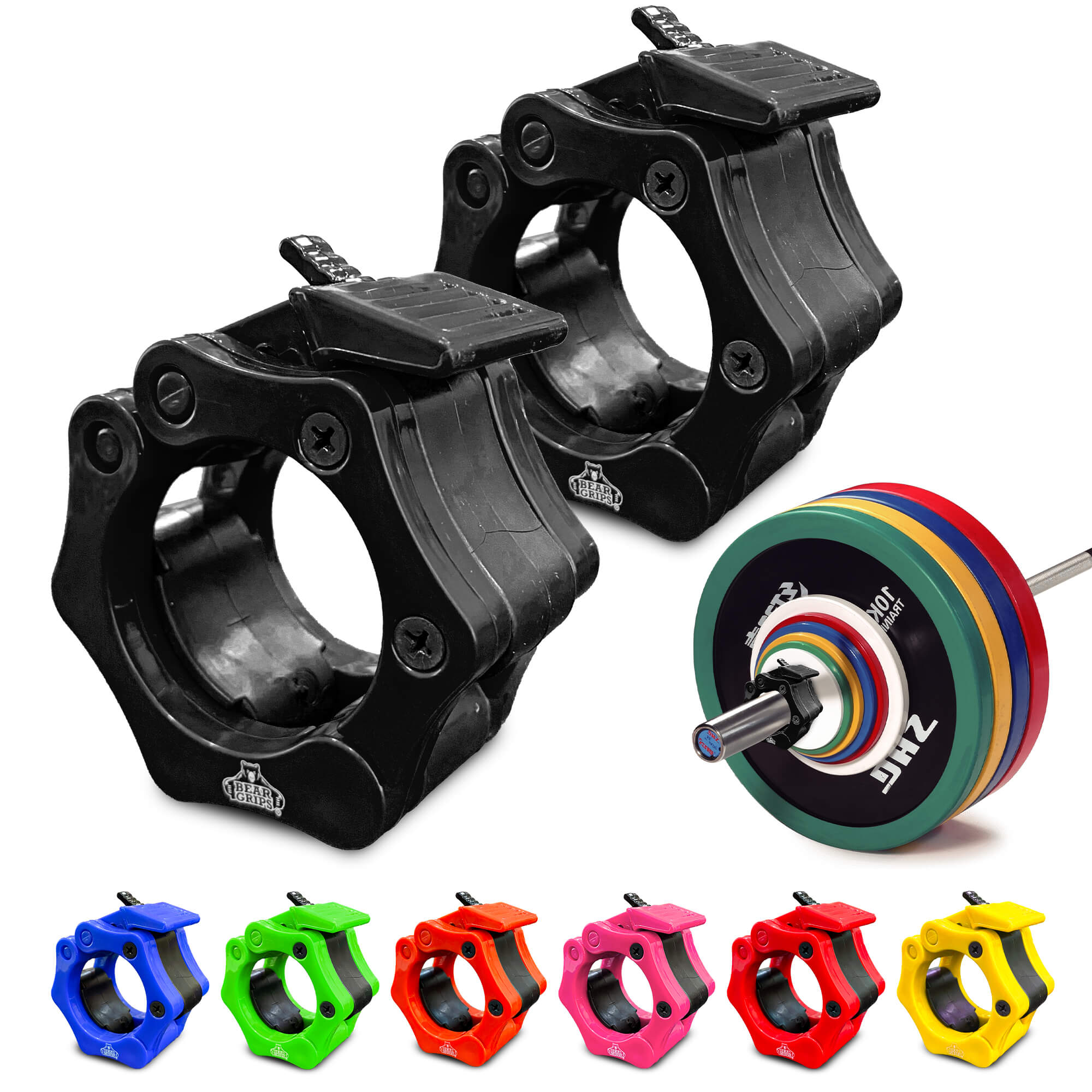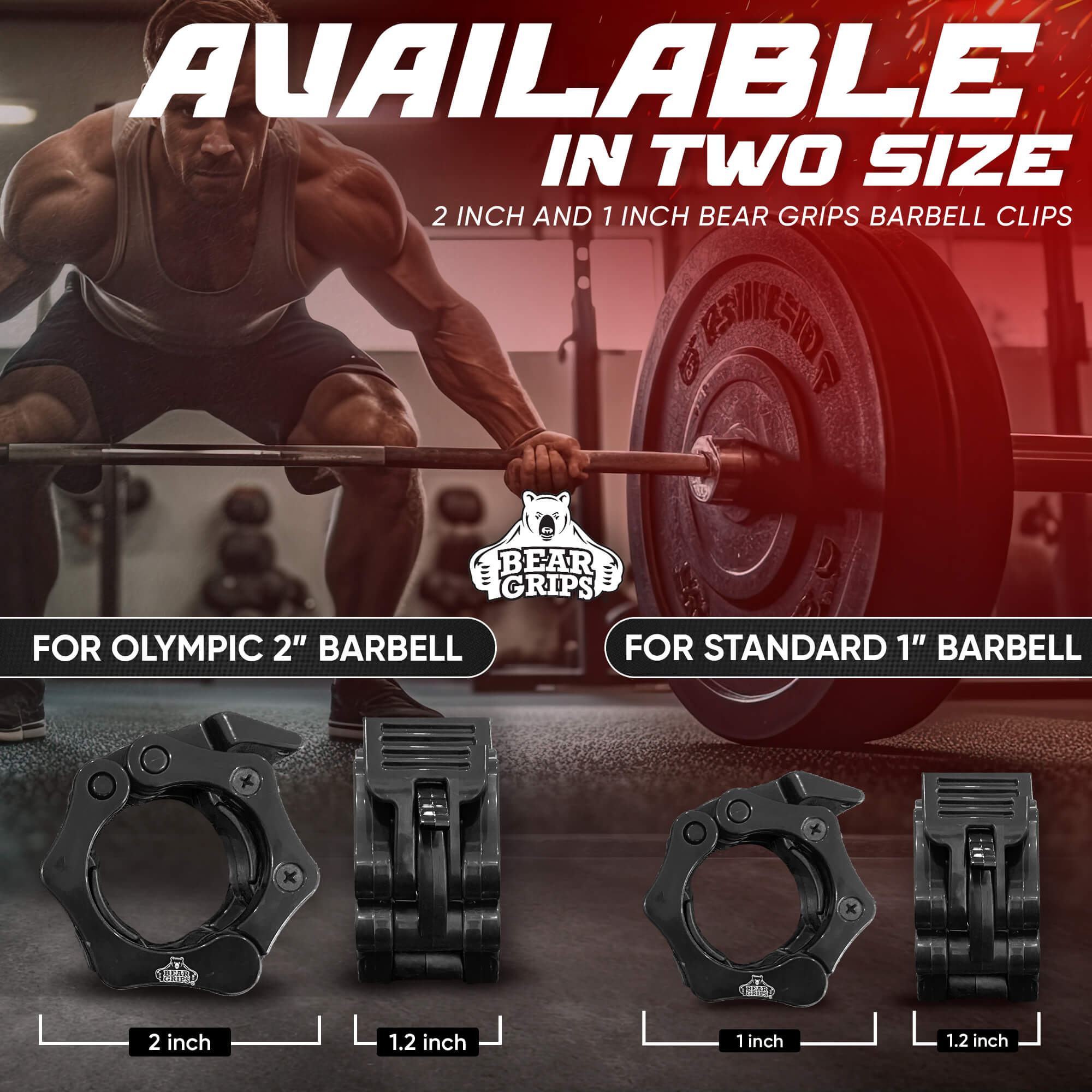
Barbell collars: Why & which are the best for you?
Share
Barbell collars, often overlooked in the world of weightlifting accessories, play a critical role in the safety and efficiency of your workouts. These small yet essential devices are designed to keep the weight plates securely attached to the barbell, preventing unexpected plate movement and ensuring a stable lifting experience.
The right barbell collar can make all the difference in your weightlifting journey. Selecting the wrong type or failing to consider key factors can lead to safety hazards, compromised performance, and even hinder your progress. In this article, we'll delve into the various types of barbell collars, their advantages and disadvantages, and provide guidance on choosing the best collar to suit your needs.

This article aims to be your comprehensive guide to barbell collars. We will explore the different types of barbell collars available on the market, offering an in-depth analysis of their designs, benefits, and drawbacks. Additionally, we will discuss the critical factors to consider when selecting a barbell collar, ensuring you make an informed decision. By the end, you'll have a clear understanding of which barbell collar is the best fit for your weightlifting goals and preferences.
Types of Barbell Collars
Clamp-Style Collars
Clamp-style collars are a popular choice among weightlifters due to their sturdy and reliable design. These collars typically consist of two metal or plastic plates with a clamping mechanism, such as a lever or screw, that tightens around the barbell's sleeves. The clamping action compresses the plates against the weight plates, securely locking them in place.
Advantages:
Disadvantages:
Spring-Clip Collars
Spring-clip collars, also known as snap collars, are characterized by their simplicity and ease of use. These collars feature a metal spring that wraps around the barbell's sleeve. When compressed, the spring applies pressure to the weight plates, holding them in place.
Advantages:
Disadvantages:
Lockjaw Collars
Lockjaw collars are recognized for their robust and dependable design. Typically made of durable plastic, these collars feature a locking latch mechanism. When closed, the latch clamps onto the barbell sleeves, creating a strong and secure hold.
Advantages:
Disadvantages:

Factors to Consider When Choosing Barbell Collars
A. Weightlifting Goals
When selecting the right barbell collar, one of the first considerations should be your weightlifting goals. Different types of workouts may require specific collar features. For instance:
B. Safety Concerns
Safety should always be a top priority when choosing barbell collars. Ensure that the collars you select can hold the weights securely in place to prevent accidents, injuries, or equipment damage during your workouts. Collars with a reputation for a strong grip and minimal plate movement, such as lockjaw or clamp-style collars, are excellent choices for safety-conscious individuals.
C. Barbell Type and Size
The type and size of your barbell play a significant role in collar selection. Different barbells have varying sleeve diameters, which affect compatibility with collars. Measure your barbell's sleeve diameter to ensure a snug fit. Some collars are designed to accommodate a range of barbell sizes, making them more versatile.
D. Ease of Use
Consider how user-friendly the collars are, especially if you value convenience and efficiency in your workouts. Spring-clip collars are known for their quick application and removal, making them suitable for fast-paced routines. Clamp-style collars, while highly secure, may take a bit more time and effort to fasten properly.
E. Durability and Material
The longevity of your collars depends on their durability and materials. Durable plastic, metal, or composite materials are commonly used. Check for collars that can withstand frequent use, dropping, and general wear and tear without losing their grip or breaking. Well-constructed lockjaw and clamp-style collars often excel in terms of durability.
F. Price Range
Your budget is an essential factor when choosing barbell collars. Collar prices can vary widely based on their features and materials. While it's tempting to opt for budget-friendly options, investing a bit more in high-quality collars can provide peace of mind regarding safety and long-term performance. Assess your budget and balance it with your desired collar features.
By carefully considering these factors, you'll be better equipped to choose the ideal barbell collar that aligns with your weightlifting goals, safety priorities, and overall workout preferences.
Best Barbell Collars for Different Needs
A. Best Barbell Collars for Powerlifting
For powerlifters who demand the utmost stability and security during heavy lifts, the Bear Grips Barbell Clamp Collars with Quick Release are an exceptional choice. These clamp-style collars offer:
B. Best Barbell Collars for Olympic Weightlifting
Olympic weightlifters require collars that facilitate swift weight changes and secure holds during dynamic movements. While Bear Grips Barbell Clamp Collars are a suitable choice, spring-clip collars may also be preferred due to their speed and ease of use.
C. Best Barbell Collars for General Fitness Enthusiasts
General fitness enthusiasts often seek a balance of convenience and reliability. In this category, Bear Grips Barbell Clamp Collars with Quick Release still stand out as they offer a secure grip and easy handling. However, spring-clip collars may also be suitable for those who prioritize quick changes in weight during circuit-style workouts.
D. Best Budget-Friendly Barbell Collars
If you're looking for budget-friendly options, spring-clip collars are usually the most cost-effective choice. While Bear Grips Collars offer excellent value for their quality, you may find more affordable options among spring-clip collar selections.
E. Best Premium Barbell Collars
For individuals who prioritize top-tier quality and performance and are willing to invest in premium collars, Bear Grips Barbell Clamp Collars with Quick Release remain a strong contender. Their combination of grip, durability, and convenience makes them a premium choice without an exorbitant price tag.
Ultimately, the Bear Grips Barbell Clamp Collars with Quick Release are a versatile option that can meet the needs of various types of weightlifters. However, the choice between clamp-style, spring-clip, or lockjaw collars will also depend on personal preferences and specific workout routines. Always consider your unique requirements when making your final decision.
How to Properly Use Barbell Collars?
Before we delve into the step-by-step guide, it's crucial to understand why securing weights with barbell collars is essential:
- Safety: Collars prevent weight plates from sliding off during exercises, reducing the risk of accidents, injuries, and damage to equipment.
- Stability: Properly secured weights provide stability, allowing you to focus on your lifts without distractions.
- Consistency: Collars help maintain consistent weight distribution, ensuring balanced and effective workouts.
Step-by-Step Guide on Applying Barbell Collars
To ensure your weights are securely fastened, follow these steps:
- Position Your Weight Plates: Slide the weight plates onto the barbell sleeves, ensuring they are evenly distributed on both sides.
- Align the Collars: Place the barbell collars on the outer edges of the weight plates, ensuring they are snugly against the plates.
- Tighten the Collars: Depending on the type of collars you have, use the appropriate fastening mechanism to tighten them. For clamp-style collars, use the lever or screw to secure them tightly. For spring-clip collars, compress the springs until they hold the plates securely in place. Lockjaw collars typically have a latch or clamp mechanism for fastening.
- Check for Security: After securing the collars, give them a gentle tug to ensure they are firmly in place and there is no movement of the weight plates. If any plates shift, re-tighten the collars.
Safety Precautions
While using barbell collars, always keep these safety precautions in mind:
- Regularly Inspect Collars: Before each workout, check the collars for any signs of wear, damage, or loose components. Replace damaged collars immediately.
- Avoid Overloading: Ensure that the combined weight of the plates does not exceed the barbell's recommended capacity. Overloading can strain the collars and lead to accidents.
- Proper Form: Maintain proper lifting form and technique to minimize the risk of plates shifting, even with secured collars.
- Stay Alert: Pay attention to your surroundings and the condition of the equipment throughout your workout to respond quickly to any issues.
Maintenance and Care Tips for Barbell Collars
- Cleaning and Storage Recommendations
To prolong the lifespan of your barbell collars and maintain their performance:
- Regular Cleaning: Wipe down the collars with a clean, damp cloth after each use to remove sweat and debris.
- Storage: Store your collars in a dry, cool place to prevent moisture buildup and corrosion. Avoid leaving them exposed to harsh elements or direct sunlight.
- Checking for Wear and Tear
Periodically inspect your collars for signs of wear and tear:
- Latching Mechanism: Ensure the latching mechanism functions smoothly and securely.
- Material Integrity: Look for cracks, breaks, or any weakening of the collar's material.
- Grip Strength: Confirm that the collar still provides a strong grip on the barbell sleeves without slipping.
- Replacing Damaged Collars
If you notice any issues during your inspections, do not hesitate to replace damaged or deteriorating collars promptly. Safety should always come first in your weightlifting routine, and maintaining your equipment is crucial to achieving a safe and effective workout.

Conclusion
In conclusion, the right barbell collar can make a world of difference in your weightlifting journey. We've explored the various types of barbell collars, their advantages, and how to select the best fit for your needs. It's essential to emphasize the significance of choosing the right collar to ensure safety, stability, and consistency in your workouts. Whether you're a powerlifter, an Olympic weightlifter, or a general fitness enthusiast, the Bear Grips Barbell Clamp Collars with Quick Release offer a versatile and reliable solution.
So, take the step towards enhancing your weightlifting experience, prioritize safety, and achieve peak performance. Don't hesitate; secure your weights with Bear Grips Collars today and elevate your lifting game. Your journey to strength starts with the right equipment. Ready to upgrade your weightlifting game with the Bear Grips Barbell Clamp Collars with Quick Release? Click here to explore and purchase the ideal barbell collars for your needs!


